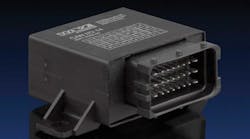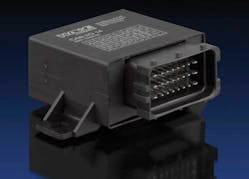CAN-IO14 control unit has four proportional outputs and four pulse-width modulation (PWM) outputs, which can also be configured as inputs. Output ports combined with six analog inputs have ranges between 0 to 10 V and 4 to 20 mA, offering simplified wiring and decentralized control of components. It is only 60 × 60 × 30 mm and is IP67 rated. It withstands temperatures from –40°F to 185°F. If all the outputs are configured as inputs, it becomes a dedicated input node.
For example, in applications with multiple sensors for load limiting or leveling, temperature, machine condition, and safety, it can convert analog and digital signals to CAN messages for use in conjunction with proportional directional spool valves, PSL CAN, and other devices on the CAN network.
When used as a slave to enhance programmable-logic valve control PLVC, functioning as both peripheral input and output nodes, it receives commands from the controller via the CAN bus and sends back real-time data. This reduces the wiring necessary to control distributed valve banks.
HAWE Hydraulics, (704) 927-5618, bit.ly/hp512hawe


